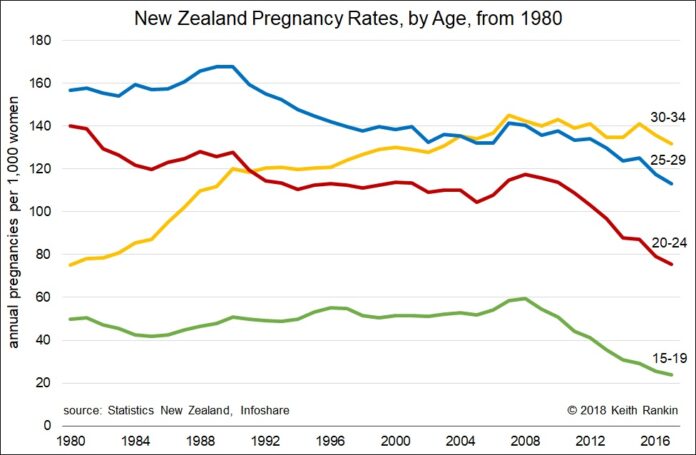Analysis by Keith Rankin
Pregnancy rates have been dropping in New Zealand, especially since 2008. While pregnancy rates among women in their twenties have been dropping since 1990, all age groups shown reveal a clear change in trend since 2008. (While not shown, it is also true that pregnancy rates for women over 35 have stabilised over the last decade, following substantial rises in the decades before 2008.)
Pregnancy rate statistics include terminations, but not miscarriages. When pregnancy trends change in this way, it could be due to either a health epidemic (eg a sudden and exacerbating fall in sperm counts), a change in contraception culture, or a change in sexual mores.
Increased infertility – especially male infertility – may be a part of the story, though it will only be a small part. This health issue cannot explain the clear turning point in the data, after 2008.
Increased general use of contraception may be part of the decline in pregnancies from 1990, amongst women in their twenties. Most of that will be linked to family planning; fewer planned pregnancies rather than fewer unplanned pregnancies. The need to repay Student Loans and to avoid incurring Child Support (both which began around 1990) will be a part of that explanation relating to fewer planned pregnancies since 1990 of women in their twenties. These are unlikely to be factors in the sharp downturn after 2008.
The most likely reason for the post-2008 trend is changes in sexual mores, specifically involving a reduction in heterosexual intimacy. This new trend is opposite to (and longer-lasting than) the change in pregnancy rates that occurred in the late 1980s. In the late 1980s, more relationships broke up, in the face of financial pressure. Also, in response to the same financial pressures (for example, very high mortgage interest rates), there was a renewed wave of female entry into the labour force, meaning that many people were forming new relationships and liaisons, leading to increases in sexual activity.
A reverse of this may have been happening this decade. While the global financial crisis may have been a trigger for change, the direct social impact of that crisis in New Zealand has been substantially less than the impact of the economic changes of the late 1980s and early 1990s.
However – with young people having become substantially less mobile (and far more likely to still be living in their parents’ homes), and women in their twenties more focussed on long-term careers than on shorter‑term financial contingencies – then forming the conventional heterosexual relationships that led to most pregnancies will have been deprioritised.
Now, more women in their thirties, having prioritised careers in their twenties, may be choosing to persist with those choices (knowing they will likely experience a childless future), at least so long as the ‘right man’ does not enter their lives. Possibly fewer women with ticking biological clocks are choosing male partners they may have misgivings about.
Finally, there may be a new wave of social puritanism this decade, leading to a less permissive society than those societies that prevailed in liberal democracies from the 1960s to the 1980s. Puritan waves have always existed in history. The rise of the smart phone and social media may have triggered the latest wave, leading to increased ‘remote’ social contact and less intimate contact. Many may have been somewhat desexualised by the easy and more personal access to pornography, for example through the now ubiquitous smartphones and laptops.
Whatever the precise mix of reasons, significant socio-demographic change has been taking place; change that has largely gone under the radar.








